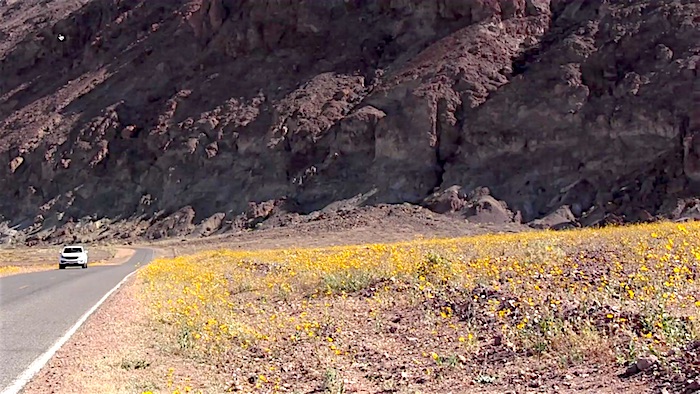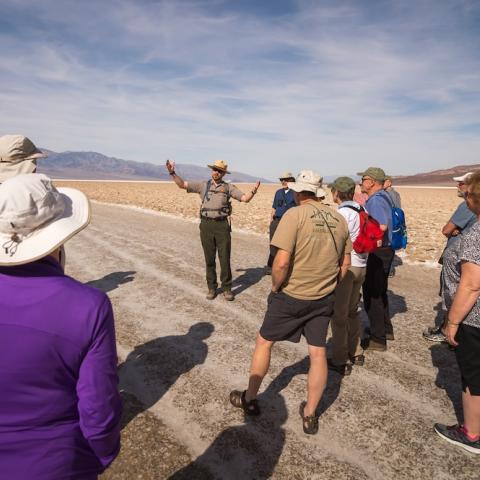Even in its death throes, the super bloom that swept across Death Valley National Park during the first handful of months in 2016 was extraordinary.
Radiating fields of Desert Gold lined the road from Furnace Creek south to the Ashford Mill Ruins and north along the road to Scotty's Castle. Walking out into the waving wildflowers, we spotted an occasional Desert Five Spot and delicate sprays of Indian Paintbrush. Were we more able botanists we no doubt would have identified Desert Gold Poppies, Golden Evening Primrose, and Fremont Phacelia.
Death Valley, that national park that straddles the California-Nevada line and which is renowned for its oven-like summer temperatures, this spring drew huge crowds for its colorful fields of flowers. Somewhat ironically, the torrential rains last October that washed out the road to Scotty's Castle up Grapevine Canyon and did enough damage to the stately old mansion that it will be a handful of years before visitors can once again tour it, were responsible for the floral fireworks.
While in many other parts of the country it's the amount of snowmelt or spring rain that spur blooms, at Death Valley the crucial period for moisture is fall and winter. With the flow from El Nino bountiful (relative to Death Valley's norm of little more than 1.5 inches per year) in late 2015 and early 2016, the bloom turned into a "super bloom," with showy displays from February into mid-March before they began to taper off in the park's lower elevations. Death Valley officials called it the best bloom in a decade.
While many referred to this year's wildflower display as a "super bloom," park officials don't officially use that term.
"I'm not really sure where the term 'super bloom' originated, but when I first came to work here in the early 1990s I kept hearing the old timers talk about super blooms as a near mythical thing -- the ultimate possibility of what a desert wildflower bloom could be," says Ranger Alan Van Valkenburg. "I saw several impressive displays of wildflowers over the years and always wondered how anything could beat them, until I saw my first super bloom in 1998. Then I understood. I never imagined that so much life could exist here in such staggering abundance and intense beauty."
Official REI Coupons and Rebates page![]()
Park officials say that when such incredible blooming seasons arrive, they typically start in the lower elevations of Death Valley, below 1,000 feet, and steadily move up in elevation as the weeks pass and the summer heat ramps up. By mid-March the lower elevation blooms are on the wane, though some nice displays can be found higher up. We saw some great ones near Twenty Mule Team Canyon and on the way to Dante's View.
But Death Valley at any time of year is a fascinating destination, whether you desire to see how much heat you can endure in mid-August or prefer the cooler months from November through February.

Badwater, perhaps the most popular photo op in Death Valley National Park/Kurt Repanshek
Badwater, at 282 feet below sea level the lowest point in North America, is a natural photo op if you can get low enough to get the right angle to include both your family or friends in the shot and the "sea level" sign high overhead on the cliff face. The aged and weathered Harmony Borax Works ruins are a window into the harsh and trying working conditions that laborers endured to mine borax from the valley floor and then ship it 165 miles by wagons pulled by 20 mules to a railhead at Mojave.
The charcoal kilns at Wildrose are another calling card from the late 1800s, while the Racetrack in the northwestern corner of the park is a natural phenomenon that draws travelers over 27 miles of rough and weary roads from Ubehebe Crater to see the trails left by rocks on an ancient lakebed. You can usually tell who is driving a rented car by the speed -- usually excessive for the rough, narrow, and winding road with its many blind curves. Our measured speed allowed us to avoid collisions with those more in a hurry.
Shop Sale & Clearance Items at REI.com![]()
Even if the Racetrack's rocks haven't moved in a while -- the one we saw in mid-March obviously had been "standing in place" for quite some time -- this area of Death Valley is intriguing and beautiful, and rich in solitude.
Solitude was one thing that was missing during this year's phenomenal bloom. Rangers said it was the most crowded time they had ever witnessed at Death Valley. From the Ashford Mill Ruins south of Badwater to the junction with the road to Scotty's Castle, motorists were pulling over to wade out into the flowers for photos. In the most crowded areas of the park, the stretch from Furnace Creek to Scotty's Castle Road during our visit, cars and trucks lined the road shoulders in both directions, and more than a few motorists seemed unconcerned about opening their car doors into the roadway with oncoming traffic...and leaving them open.
Free Shipping on Orders Over $50 at Backcountry.com![]()
Unfortunately, the National Park Service in Death Valley lacks the staffing resources to deal with this sort of visitation crush. During our four-day stay we roamed from the mill ruins and Badwater to Artists Palette, from Harmony Borax Works to Wildrose and even the Racetrack and up to Dante's View, and the only rangers we saw were two who were leading school children on a hike into the Mesquite Sand Dunes near Stovepipe Wells.

The ore wagons on display at Harmony Borax Works/Kurt Repanshek
So no on-site interpreters available, or law enforcement rangers to help with traffic control.
"Sadly, we have only four field rangers at the moment, covering 3.4 million acres. That is not enough," Superintendent Mike Reynolds told me several days after my visit when I wondered in an email how many rangers he has on staff. "We also have an extremely high demand for (emergency calls), which primarily occur between Stovepipe Wells and Furnace Creek."
Now, to put a little more perspective on Death Valley's staffing situation, and its disparity compared to other park units, at Yellowstone National Park, which is roughly 1.2 million acres smaller than Death Valley, there are between 43-48 permanent law enforcement field rangers throughout the year for resource and visitor protection, and another 44-49 seasonal law enforcement field rangers during the summer.
Staffing, or lack thereof, also seemed to be an issue for the campground restrooms at Furnace Creek. The two shared by visitors staying in both the concessionaire-operated Fiddler's Campground and the Park Service-run Furnace Creek Campground were filthy at certain points in the day. They're cleaned just twice daily, according to the Xanterra desk clerk at Furnace Creek. Similar problems have surfaced in Zion National Park, and no doubt many other units.
I will say that if I ever plan to camp at Furnace Creek again, the Park Service will get my business, not Xanterra Parks & Resorts. The Park Service campground is accessed by nicely paved roads, has a separate area for tents, and there are quite a few shaded sites. Some sites have large tamarisk trees spaced wide enough to set your tent up beneath the branches. Best of all, you can reserve a specific site months before you go.
The Fiddler's Campground, meanwhile, is obviously intended for RVs. While you can pitch a tent here, the ground is packed gravel, and only about half the sites come close to offering shade, and there are no picnic tables. When you reserve a site through Xanterra's website, there is no option for choosing a specific site. While there are some nicely shaded sites, those apparently are doled out to those who make reservations months in advance and who are familiar enough with the layout to request a site near the stand of tamarisk trees.
If there is a plus to the Fiddler's Campground, your $18/night fee includes access to the swimming pool at Furnace Creek and to the showers there. But if you do land a spot in the Park Service campground, you can still purchase access to these facilities on a daily basis.
To avoid the crowds, plan your visit between July 1 and September 1. You'll have most of the park to yourself...as well as daily temperatures soaring above 100 degrees Fahrenheit!






 Support Essential Coverage of Essential Places
Support Essential Coverage of Essential Places







Comments
If NPS would end the frivolous litigation across the country there would be plenty of budgeted $$$$ to hire more people and reduce the $12B maintenance backlog. NOTE: new litigation in Golden Gate over dog on leashes and Cape Reyes to remove ranchers and dairies.
It's not the NPS that brings the lawsuits...
If its not the NPS, then who allowed the Yosemite trademarks to be approved for an outside company in the first place??